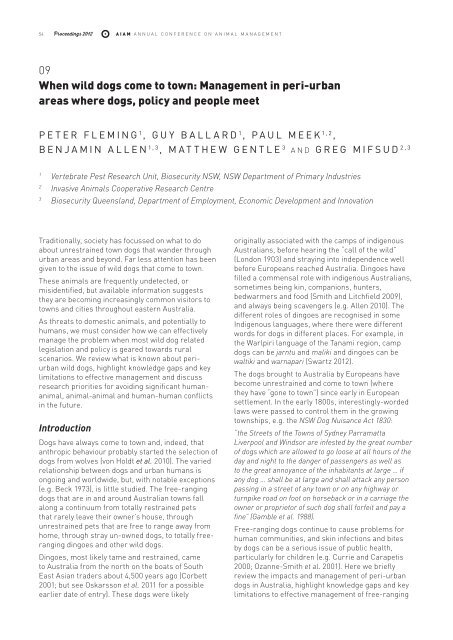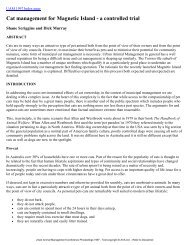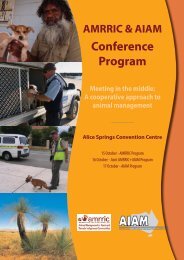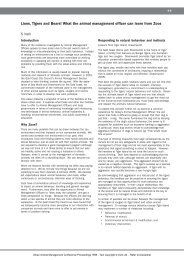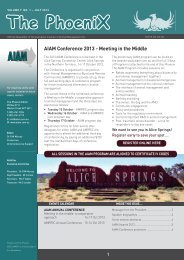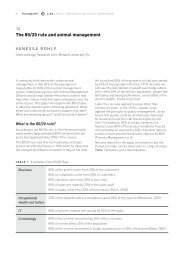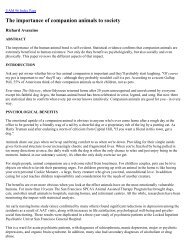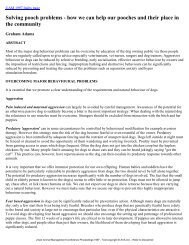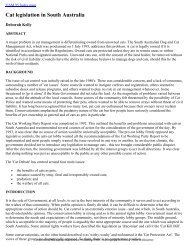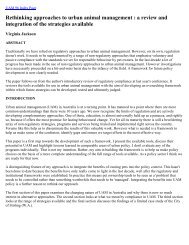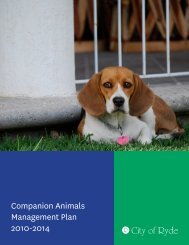Proceedings OF ThE - Australian Institute of Animal Management Inc
Proceedings OF ThE - Australian Institute of Animal Management Inc
Proceedings OF ThE - Australian Institute of Animal Management Inc
You also want an ePaper? Increase the reach of your titles
YUMPU automatically turns print PDFs into web optimized ePapers that Google loves.
54 <strong>Proceedings</strong> 2012<br />
AIAM Annual Conference on <strong>Animal</strong> <strong>Management</strong><br />
09<br />
When wild dogs come to town: <strong>Management</strong> in peri-urban<br />
areas where dogs, policy and people meet<br />
Peter Fleming 1 , Guy Ballard 1 , Paul Meek 1,2 ,<br />
Benjamin Allen 1,3 , Matthew Gentle 3 and Greg Mifsud 2,3<br />
1<br />
Vertebrate Pest Research Unit, Biosecurity NSW, NSW Department <strong>of</strong> Primary Industries<br />
2<br />
Invasive <strong>Animal</strong>s Cooperative Research Centre<br />
3<br />
Biosecurity Queensland, Department <strong>of</strong> Employment, Economic Development and Innovation<br />
Traditionally, society has focussed on what to do<br />
about unrestrained town dogs that wander through<br />
urban areas and beyond. Far less attention has been<br />
given to the issue <strong>of</strong> wild dogs that come to town.<br />
These animals are frequently undetected, or<br />
misidentified, but available information suggests<br />
they are becoming increasingly common visitors to<br />
towns and cities throughout eastern Australia.<br />
As threats to domestic animals, and potentially to<br />
humans, we must consider how we can effectively<br />
manage the problem when most wild dog related<br />
legislation and policy is geared towards rural<br />
scenarios. We review what is known about periurban<br />
wild dogs, highlight knowledge gaps and key<br />
limitations to effective management and discuss<br />
research priorities for avoiding significant humananimal,<br />
animal-animal and human-human conflicts<br />
in the future.<br />
Introduction<br />
Dogs have always come to town and, indeed, that<br />
anthropic behaviour probably started the selection <strong>of</strong><br />
dogs from wolves (von Holdt et al. 2010). The varied<br />
relationship between dogs and urban humans is<br />
ongoing and worldwide, but, with notable exceptions<br />
(e.g. Beck 1973), is little studied. The free-ranging<br />
dogs that are in and around <strong>Australian</strong> towns fall<br />
along a continuum from totally restrained pets<br />
that rarely leave their owner’s house, through<br />
unrestrained pets that are free to range away from<br />
home, through stray un-owned dogs, to totally freeranging<br />
dingoes and other wild dogs.<br />
Dingoes, most likely tame and restrained, came<br />
to Australia from the north on the boats <strong>of</strong> South<br />
East Asian traders about 4,500 years ago (Corbett<br />
2001; but see Oskarsson et al. 2011 for a possible<br />
earlier date <strong>of</strong> entry). These dogs were likely<br />
originally associated with the camps <strong>of</strong> indigenous<br />
<strong>Australian</strong>s, before hearing the “call <strong>of</strong> the wild”<br />
(London 1903) and straying into independence well<br />
before Europeans reached Australia. Dingoes have<br />
filled a commensal role with indigenous <strong>Australian</strong>s,<br />
sometimes being kin, companions, hunters,<br />
bedwarmers and food (Smith and Litchfield 2009),<br />
and always being scavengers (e.g. Allen 2010). The<br />
different roles <strong>of</strong> dingoes are recognised in some<br />
Indigenous languages, where there were different<br />
words for dogs in different places. For example, in<br />
the Warlpiri language <strong>of</strong> the Tanami region, camp<br />
dogs can be jarntu and maliki and dingoes can be<br />
waltiki and warnapari (Swartz 2012).<br />
The dogs brought to Australia by Europeans have<br />
become unrestrained and come to town (where<br />
they have “gone to town”) since early in European<br />
settlement. In the early 1800s, interestingly-worded<br />
laws were passed to control them in the growing<br />
townships, e.g. the NSW Dog Nuisance Act 1830:<br />
“the Streets <strong>of</strong> the Towns <strong>of</strong> Sydney Parramatta<br />
Liverpool and Windsor are infested by the great number<br />
<strong>of</strong> dogs which are allowed to go loose at all hours <strong>of</strong> the<br />
day and night to the danger <strong>of</strong> passengers as well as<br />
to the great annoyance <strong>of</strong> the inhabitants at large … if<br />
any dog ... shall be at large and shall attack any person<br />
passing in a street <strong>of</strong> any town or on any highway or<br />
turnpike road on foot on horseback or in a carriage the<br />
owner or proprietor <strong>of</strong> such dog shall forfeit and pay a<br />
fine” (Gamble et al. 1988).<br />
Free-ranging dogs continue to cause problems for<br />
human communities, and skin infections and bites<br />
by dogs can be a serious issue <strong>of</strong> public health,<br />
particularly for children (e.g. Currie and Carapetis<br />
2000; Ozanne-Smith et al. 2001). Here we briefly<br />
review the impacts and management <strong>of</strong> peri-urban<br />
dogs in Australia, highlight knowledge gaps and key<br />
limitations to effective management <strong>of</strong> free-ranging


